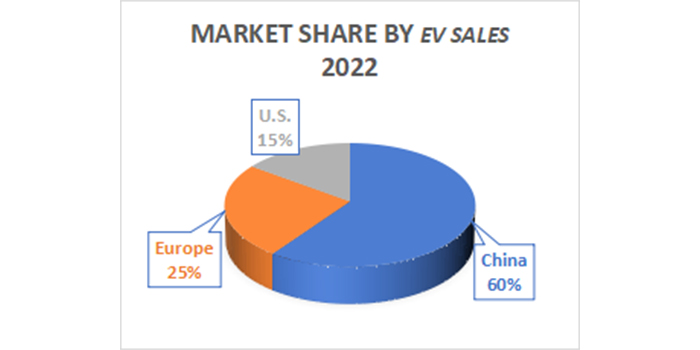The transition which is happening in the automotive industry is breathtaking, the adoption rate of electric vehicles all around the globe is on the inclining phase. China is the country which has approx. 60% of share in electric vehicles sold. Whereas the growth of electric vehicles in Europe and U.S. is on a stagnant phase, Despite of the geopolitical tensions and economic constrains the adoption rate for electric vehicle is increasingly steadily. For instance, we have mentioned the adoption rate of previous year.

There are several issues which are been confined at this very moment which includes the shortage of semiconductors, the shortage of parts and the bottleneck situation related to production. The high prices of energy and the raw materials is making the CEOs and other board of directors very much anxious. And for this the global strategic management is the only possible way to create a sustainable business model in automobile industry. As the rising demand for the lithium-ion batteries and other critical elements are on the urge the international OEMs are particularly thinking about increasing the partnerships with the Chinese based players for the supply of battery packs.

China is considered to be the nation with the highest exportation rate and their most trading partner is Europe. There are several reasons why China is the largest exporter the main reasons include the government support, the higher investments and the technological infrastructure. Here are some of the examples of M&A happening out there.
| OEM | Supplier | M&A Purpose |
| General Motors | Lithion | Battery production |
| Ford | CATL | Battery Eco System |
| Volkswagen | XPeng | Greenfield investment for battery production. |
The only objective behind mentioning the strategic partnerships is to give you a real time scenario and to prove our statement. The strategic partnerships can lead to several benefits which includes the support for higher production and meeting the demand of electric vehicles. When we look from supplier end the Tier 1 and Tier 2 suppliers are very much concern about how the industry is shaping and will shape in coming decade. The OEMs are very much interested in using the raw materials which contribute to goal of net zero emissions, and light weight vehicle.
The suppliers are developing the products which is very much aligned with the sustainable goal of the OEM and the industry as well. The upcoming trends in automotive industry mainly include the autonomous, the E/E, connected cars, ADAS and so forth. The trends allow the suppliers to redevelop the products and find a way for vertical integration in order to fulfill the demand of OEMs.
Analysis
If we look at our past and try to gain better insights from it, we can understand how global disruptions may cause issues related to supply. This is where the grey space for the domestic suppliers increases, the domestic players should focus on investing and try to capture the attention of OEMs for the supply of major automotive components. And there are some investments which are aligned in order to improve the domestic production. Because the uncertainties of future global disruption and geopolitical tension can harm the future aspirations of the OEMs.
Value Chain
The most important part for the OEM is to improve the value chain element by reducing the cost and at the same time meet the climate goals. HOW? The M&A and the investments in the raw materials looking at the future of automotive industry will be the key areas to focus on. One of the surveys conducted by the McKinsey which stated most of the suppliers and OEMs are not pre active abut are in reactive mode which means the company are taking action when the disruptions are happening. This can be pre examined by improving the environmental awareness and reducing the dependency factor. Yes! there might be question related to the need of larger investment but the increase of local M&A and investments for the inhouse production will always be the smarter move.